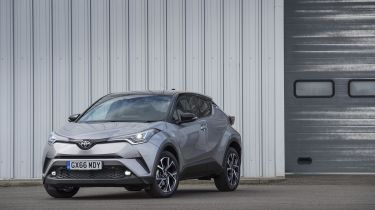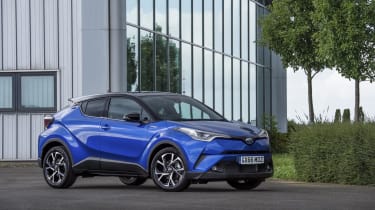Toyota C-HR Hybrid
"Efficient, stylish and easy to drive, the Toyota C-HR Hybrid is an appealing car – as long as you can live with the gearbox"
Pros
- Efficient
- Stylish
- Sharp handling
Cons
- CVT gearbox is noisy
- Limited view from rear windows
- Boot small for an SUV
The Toyota C-HR Hybrid is a radical-looking car, but underneath it features Toyota’s tried-and-tested hybrid setup. This comprises a 1.8-litre petrol engine and an electric motor, which produce 120bhp and power the front wheels – there’s no four-wheel-drive option as there is with the 1.2-litre C-HR.
Such a setup promises strong efficiency, and while the C-HR Hybrid’s on-paper economy of 74.3mpg may be hard to match unless you drive very carefully, it should still be the default choice if you’re after a C-HR and want minimal running costs.
And even though the Hybrid C-HR costs around £2,500 more than the standard model, its low CO2 emissions of 86g/km mean company-car customers should save money on tax compared to the 1.2-litre model. Other SUVs to consider if low running costs are a priority include the hybrid version of the Toyota RAV4, or a diesel-engined SEAT Ateca, Nissan Qashqai or Peugeot 3008 – although that last car is due to get a hybrid setup in 2019.
So on paper, the C-HR Hybrid stacks up nicely – as it does in the metal. It bares the same eye-catching looks as the standard model, and while these come at the cost of visibility from those steeply raked rear windows, there’s a reasonable amount of space back there.
More reviews
The dashboard design is a big step forward for Toyota, with plenty of soft touch and glossy black surfaces appealing to both the eye and the hand. It’s a modern and sleek interior and one owners are likely to appreciate both on initial impressions and over time.
All models come with alloy wheels, a reversing camera, adaptive cruise control and an eight-inch touchscreen that’s neatly integrated into the swooping lines of the dashboard. Step up from Icon to Excel trim for sat nav and keyless go, while top-spec Dynamic brings a two-tone roof/body combination, LED lights, auto-folding mirrors and a self-parking system.
As it’s a conventional hybrid rather than a plug-in model, the C-HR doesn’t have an all-electric range as such and its batteries are charged by the 1.8-litre petrol engine. Drive it carefully around town and you’ll be cruising around silently on battery power alone, although at higher speeds the C-HR relies more on the engine than it does the electric motor.
Do make sure you’re happy with the C-HR’s CVT (continuously variable transmission) gearbox before signing anything, though. This setup works okay in the Prius hybrid, but in the transition to the C-HR something seems to have been lost in translation, as it’s more intrusive in this iteration.
Treat the C-HR Hybrid carefully and you won’t have much of a problem, but under moderate to heavy acceleration the engine’s revs rise quite prominently, only falling off as the car reaches its required speed – something that’s particularly noticeable when joining motorways or accelerating out of town. This is a shame, as while it’s not a quick car (0-62mph takes 11 seconds), the C-HR handles very nicely indeed.
As an ownership proposition, the C-HR is excellent. Toyota’s strong five-year/100,000-mile warranty stands it in good stead, as does its five-star Euro NCAP safety rating. And while the company’s 11th-place finish out of 27 brands in our Driver Power customer satisfaction survey is decent rather than exceptional, an eighth-place result for reliability is more encouraging.













